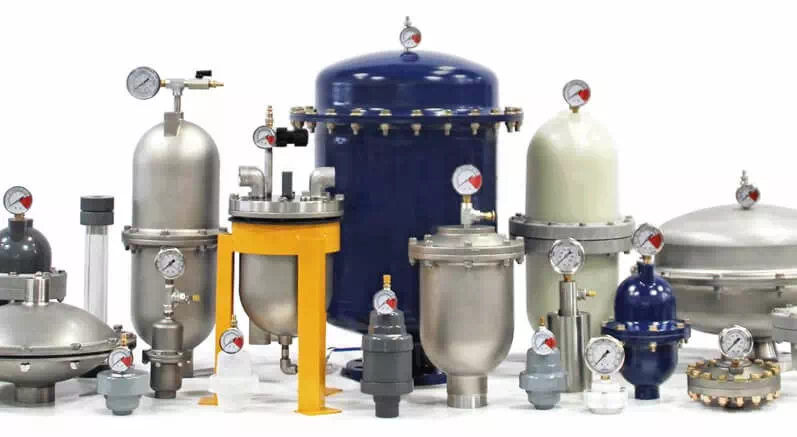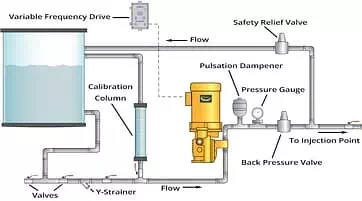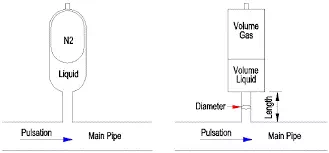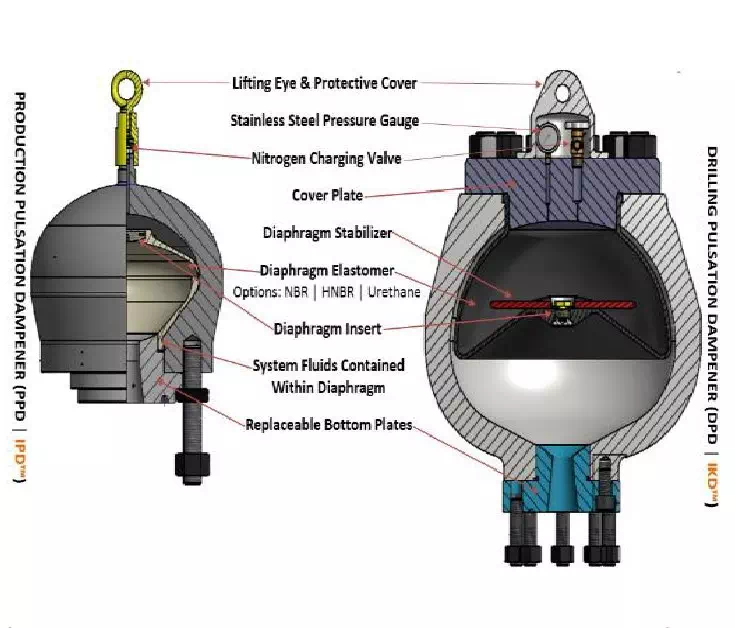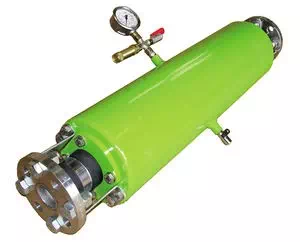Pulsation dampener คืออุปกรณ์ที่ติดตั้งในระบบท่อ เพื่อใช้ปรับการใหล (Flow) ของของใหล (Fluid) ในท่อให้ปริมาณคงทึ่ ทำให้การไหลในระบบท่อราบเรียบ สม่ำเสมอ ไม่กระตุกตามรอบที่หมุน (Rotating stroke) โดยเฉพาะการใหลและความดันที่เกิดขึ้นของปั๊มหรือคอมเพรสเซอร์แบบปริมาณการไหลคงที่ (Positive displacement pump or compressor, PD type) เช่นปั๊มแบบโลบ, สกรู, พีซี, แวน, ลูกสูบ, เกียร์, รีดท่อ, เป็นต้น
ปั๊มหรือคอมเพรสเซอร์ชนิดเหล่านี้การไหล หรือความดันจะกระตุก (Spike, pulse) เป็นลักษณะของ Pulsation flow ตามรอบการหมุนของโรเตอร์ (Rotor) หรือตามการชักเข้าออก (Stroke) ของลูกสูบ ทำให้การทำงานของกระบวนการผลิตไม่ราบเรียบ (Non - smooth flow)
ระบบหมุนเวียนเพื่อส่งน้ำมันหล่อลื่น (Lubricating system) ให้ระบบแบริ่ง (Bearing) รับน้ำหนักของคอมเพรสเซอร์ กังหันแก๊ซ กังหันไอน้ำ มีขนาดโรเตอร์ขนาดใหญ่ น้ำหนักมาก ต้องการแรงยกมาก จึงต้องการความดันน้ำมันสูงและการใหลของของน้ำมันต้องใหลราบเรียบมาก
การทำงานของ Pulsation dampener
Active pulsation dampener เป็นตัวเก็บสะสมพลัง จะให้ความดันแก่ระบบเมื่อความดันในระบบต่ำลง และเก็บสะสมความดันเมื่อความดันในระบบสูงขึ้น (Dampener) ทำให้การใหลหรือความดันของระบบท่อจะถูกปรับให้คงที่ตลอดเวลา
Pulsation dampener ติดตั้งที่ขาออกของปั๊มหรือคอมเพรสเซอร์ จะทำการใหลราบเรียบ 99% และไม่มีการสั่นเกิดขึ้น
รูปแสดงระดับของความดันหลังติดตั้ง Pulsation dampener
Types of Various Pulsation Dampeners
- Membrane Pulsation Dampener: A membrane-type dampener provides a solid separation between the pumping fluid and the compressible gas. The membrane resides within the dampener and allows for the pressure to be transferred to the gas, without any mixing of the gas into the fluid.
- Bladder Pulsation Dampener: A bladder type dampener fully encloses the compressible gas within a bladder. This setup ensures there is no leakage of the gas into the pumping fluid. The pressure pulsations are transferred to the gas as the bladder expands and contracts.
- Bellows Pulsation Dampener: A bellows-type dampener works the same way as a bladder type dampener. However, by using a bellows-type design, it can be made with other types of materials such as PTFE or Stainless Steel. This type of dampening system is used when pumping corrosive materials that may deteriorate more common materials.
- Pressure Vessel Style: A pressure vessel dampener, sometimes referred to as a “zero maintenance” style dampener does not use any moving parts. They are only effective at very high pressures. Fluids, including water, do have some degree of compressibility. Pressure Vessel Style dampeners allow for the pressure of the fluid to be dissipated within the vessel by the small amount of compressibility within the pumping fluid. In very high-pressure applications, a pressure vessel style dampener may be the only type of dampener available. It is important to note that this style of dampener does not operate as effectively as other types of dampeners.
- Flexible piping: Although it is not recommended, flexible piping or hose can act as a pulsation dampener in emergency situations. As the fluid flow changes, the flexible piping is able to “move” and allow a dampening effect on the fluid. Flexible piping still requires proper sizing to reduce pressure spikes. Improper usage may result in damage to equipment and endangerment of equipment operators.
ประโยชน์ของ Pulsation dampener
- ทำให้การใหลราบเรียบ (Smooth flow) มีความดันคงที่ มีผลให้กระบวนการผลิตเกิดอย่างต่อเนื่อง
- กันแรงกระแทก (Water hammer and surge) จากของใหลในระบบท่อ
- ป้องกันการสั่น (Vibration) ของระบบท่อ
- ป้องกันอุปกรณ์ในระบบท่อจากการสั่น แรงกระแทกของของใหล
- ทำให้การใหลราบเรียบ การผลิตจะดี
- ประหยัดพลังงาน
- ติดตั้งง่าย
- ลดค่าบำรุงรักษาของปั๊มหรือคอมเพรสเซอร์
- อายุของปั๊มหรือคอมเพรสเซอร์ยืนยาวขึ้น
คำแนะนำในการติดตั้ง Pulsation dampener
- The size or volume of the dampener installed at the suction must be approximately twice that of the dampener installed at the discharge.
- The size of the connection port of the dampener must be larger than or equal to the diameter of the suction pipe.
- The dampener must be installed with the least possible pipe length between it and the pump liquid inlet port.
- The gas charging or inflating pressure must be below atmospheric pressure
- The image above shows the visible pulsations created by a reciprocating pump. Using flexible hoses on the inlet and outlet, the pressure fluctuations through the hose can easily be seen. Since steel piping is more rigid, it may be more difficult to visually see pressure vibrations before damage to piping and the surrounding systems takes place. It is important to correctly determine if a dampener is needed and to correctly install the required size before operating the pump system.
- It is important to note that pressure pulsations are not a function of pressure. The operational pressures of a system have very little effect on the resulting pressure pulsations. Both suction and discharge sides of a reciprocating pump are susceptible to pulsations and resulting damage. Both the suction and discharge dampeners operate independently of each other. Proper sizing and installation of both suction and discharge dampeners are required for proper protection of pumping equipment and systems.
บริษัทไอคิวเอส (IQS) เป็นตัวแทนการขายและการบริการของ Fox Srl. Pulsation dampener ซึ่งมีชื่อเสียงจากประเทศอิตาลี ผลิตภัณฑ์ใช้กันอย่างแพร่หลายในอุตสาหกรรมทั่วโลก
บริษัทไอคิวเอส (IQS) โดยการสนับสนุนด้านเทคนิคจากผู้ผลิต สามารถบริการแนะนำการเลือกชนิดที่ใช้ Pulsation dampener ให้คำปรึกษาการออกแบบระบบ การใช้งาน และการบำรุงรักษา
สนใจสินค้า บริการหลังการขาย หรือต้องการปรึกษา ติดต่อ บ. อินทีเกรทเต็ด ควอลิตี้ เซอร์วิสเซส จำกัด

